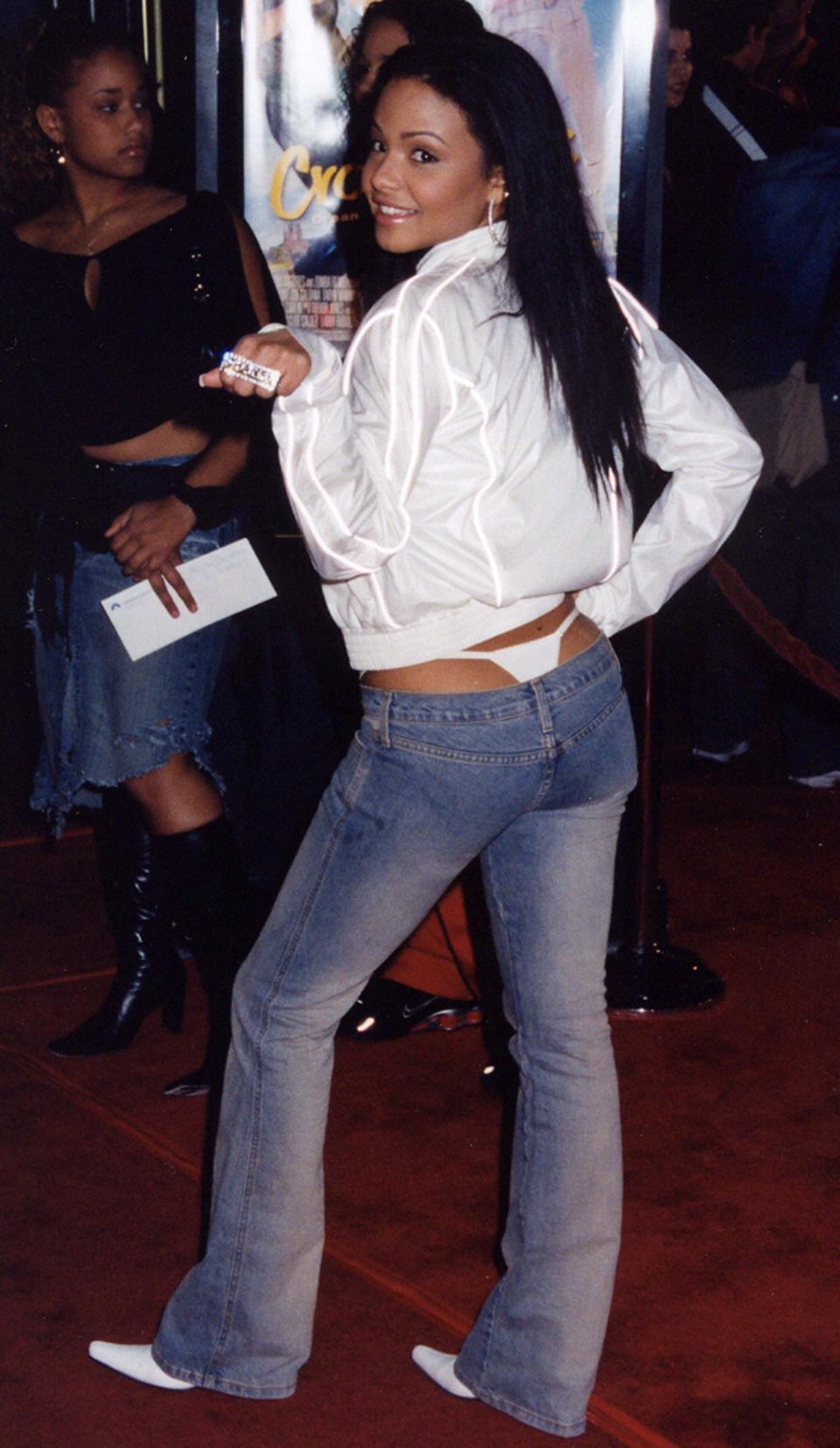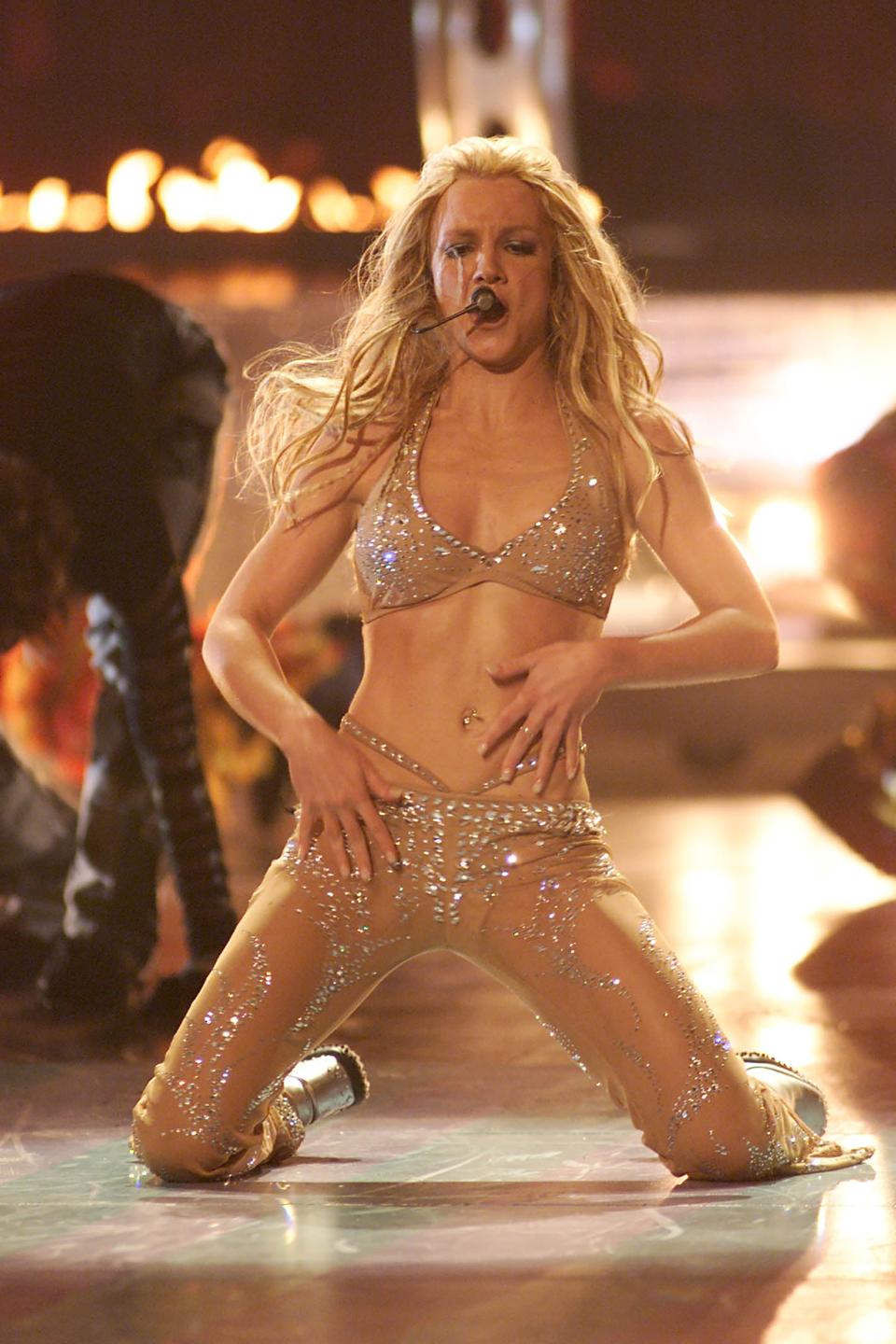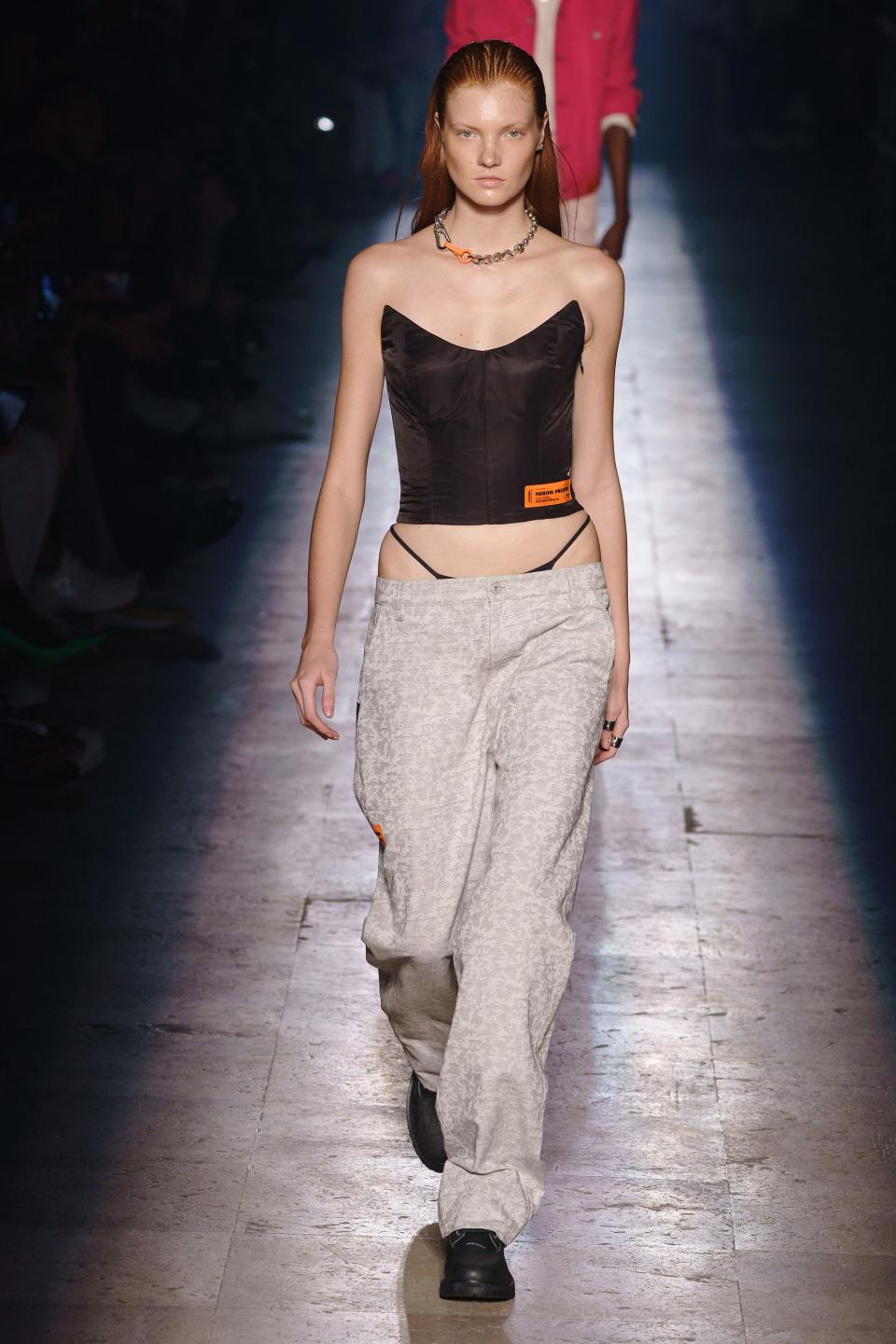The Visible G-string Is Officially Making Its Comeback — Here’s What It Means
When I meet Rowan Blanchard during New York Fashion Week, she’s wearing a sequin top and leather pants, with a G-string underneath that was pulled up to her hips. She seems to exude confidence, and though she admits she’s navigated some personal challenges this year, fashion has become a way for her to express herself. Regarding the night’s unexpected choice in underwear, Rowan tells me, "My stylist...added the G-string. I'm really into it.” I tell her I think G-strings are making a comeback and without hesitation she replies, “I don't know if they ever went away.”
Ever since that convo, I haven’t stopped thinking about the complexities of the G-string — what function they serve, what they say about the people who wear them, how they’ve come in and out of fashion — and to some extent I agree with Rowan: They really never did go out of style. Though recently it seems that people have been wearing them more proudly (again). You know, outside of their pants, rather than hiding them behind the fabric covering their bottoms. It’s a style more commonly synonymous with the noughties. After all, the 2000s saw everyone from Britney Spears to Christina Aguilera and Christina Millian to Halle Berry donning the look.

86111329
Getty ImagesOne of my earliest memories of the G-string was when Manny Santos (played by Canadian actress Cassie Steele) from Degrassi wore a bright blue bedazzled one above her low-rise jeans to school during the show’s 2003 episode, “U Got the Look.” During the episode, Manny takes a trip to the mall with her BFF Paige Michalchuk. Declaring that it’s time to change her look and dress less “tame,” Manny excitedly purchases a thong, to her friend’s dismay. And later, Manny strolls through the hallways confidently repping her new look as the camera pans to the bewildered faces of her fellow teenage male classmates. Watching that iconic moment on my television screen when I wast 14 years old, I remember thinking about the connection between my own style and femininity and how clothing was a vehicle I too could use to express my sexuality.

2221274
Getty ImagesSince the underwear item’s past prime, culture has shifted in some major ways, some not so much. Still, the G-string has retained its function (who doesn’t love a no-panty-lines look?) and some of its meaning. And in the last year, more celebrities have been ushering the look back into style. Just this past May at the Met Gala, Hailey Bieber wore a bubblegum-pink dress, complete with a G-string thong that had an Alexander Wang logo. Then in June, Bella Hadid appeared on the Versace runway during the brand’s spring 2020 menswear show wearing a black G-string with metal clasps at the sides, worn above her sequined pants. She was also previously spotted at an airport wearing one with a wide band and bold text and coming out from under her sweatpants.
Also in June, rising actress Alexa Demie showed up to the Los Angeles premiere of HBO’s hit show Euphoria wearing a snakeskin dress with a low, open back and a black G-string thong with rhinestone straps — an outfit not unlike something her famed character, Maddy Perez, would wear. Other celebrities including Kylie Jenner, Kim Kardashian, and Jennifer Lopez have also been spotted with stringy thongs sticking out of their low-rise pants (something The Cut predicted we’d start seeing more of back in December 2018). And with all things noughties already making a comeback, including Skechers sneakers, Ugg boots, crop tops, cargo pants, and so much more, it makes sense that G-strings (also called “whale tales”) are also making their way back into our hearts (and closets).
We already know that the cycle of fashion trends is never-ending, and with culture being so invested in all things nostalgic right now, the return to visible G-strings is not unexpected by any means. But where did it originally come from and what does its return now mean? And has it always been associated with fetish culture? Let’s unpack.

Jennifer Lopez
BackgridAccording to Roberta Gorin-Paracka, a fashion historian and Teen Vogue contributor, “the concept of the G-string as a garment has been around for thousands of years [including] variations on the loincloth, or the fundoshi, the undergarment worn by Japanese men until WWII.” As Toronto-based fashion historian Alanna McKnight says, “Thongs have been a staple garment across human cultures for centuries, be it worn by indigenous men in the Amazon, or by dancers in Pompeii, they are the most effective way to provide protection and modesty using the least amount of material.” Audrey Millet, a fashion historian based in Paris, adds that “some commentators also see the G-string as an interpretation of sporting goods, such as jockstraps, that reveals the power of the thighs and buttocks.”
However, when it comes to seeing the G-string as a sexualized or fetishized object in Western culture, Gorin-Paracka says we should actually credit a conservative figure for its emergence into popular culture as it was “the mayor of New York City in the 1930s, Fiorello La Guardia, [who] demanded that the city's nude dancers cover themselves out of respect to the multitude of visitors making their way to the 1939 World's Fair, an origin story that's repeated in every history of the garment.” Leading up to the 1930s, G-strings became a way for strippers and burlesque dancers to show as much skin as possible without embracing total nudity, a requirement for modesty laws, which at the time varied from state to state. “They were first made commercially available in the late 1930s by Charles Guylette in New York, who sold exclusively to burlesque performers,” adds Gorin-Paracka.
The G-string, which was often sequined and rhinestoned, was “a cultural marker of glamourous erotic entertainment,” says Jo Weldon, a burlesque historian and author of The Burlesque Handbook. “Non-professionals wore them for costumes or naughty private play, but generally not as underwear until Frederick's of Hollywood began to make a more wearable version of them available as underwear through their catalogs and stores.”
McKnight says that thongs remained a garment for salacious stage performances and images until the thong bikini of the late 1960s, when it entered modern style as beachwear. Then in the 1970s, Gorin-Paracka says, “The Austrian designer Rudi Gernreich popularized the thong for both men and women with his 1974 thong.” One of the thongs is now part of the Costume Institute at the Met Museum's permanent collection.
“Gernreich celebrated the body and broke down gender distinctions in clothing with his unisex designs, creating a unisex thong swimsuit that same year.” Gernreich was interested in erogenous zones, including the monokini (then a topless bathing suit that was famously worn by model Peggy Moffitt), and the pubikini, which Gorin-Paracka says, “was little more than a full panty with a low scoop front, which came with a green pencil and highlighter meant for the wearer to both expose and dye their pubic hair.”
Millet considers the 1970s the years that truly birthed the G-string, but its more practical, invisible side was adopted in the 1980s. More women were working for corporate companies in the 1980s, and as they cultivated their physical appearance and fitness became more popular, fashion required invisible underwear rather than VPL, or visible panty lines, explains Millet.
“Starting in the 1980s, there was a growing Western obsession with physical fitness and transforming the body into something worth putting on display,” says Gorin-Paracka. Thongs and G-strings worn as swimwear and underwear put a woman’s assets on display for all the world to see. It was during the 1980s that the underwear became available via lingerie catalogs and retail stores, says Millet, eventually becoming as available as any style of panty after the 1990s. Plus, famed designers Halston and Stephen Burrows debuted clothing for women that was cut close to the body, including jersey dresses, tight skirts, and pantsuits. The item became functional, giving women the opportunity to show off their bodies sans lines and creases.
By the 1990s and early 2000s, the thong became an erotic item being worn more visibly. Serving as a clothing piece that allowed women to assert their power, sensuality, and sexuality, it was no longer just an undergarment. “Celebrity fashion is often provocative,” according to McKnight. “And young, female celebrities over the past 30 years have held this standard by being fully clothed, with a hint of the ‘whale tail’ peeking out of the back of their pants, or the elastic bands fully exposed above their waistlines, a signifier of their sexuality that might not otherwise be expressed if not for a peek, an unconscious nod to the G-string’s beginnings on the burlesque stage.”
With tight, low-rise pants being the norm, regular, low-cut panties were too voluminous. As singer Sisqó declared via his hit single, “Thong Song” in 1999, thongs, especially G-strings, were celebrated by pop culture, representing a sense of subversion and defiance against outdated views. It wasn’t long before companies jumped on the bandwagon and started selling their own versions.
“Manufacturers took it over, embellishing it with glitter or rhinestones, slogans, and surfing on its success with celebrities to make it a piece of the teenage closet,” Millet says, explaining that eventually, critics blamed the G-string of being responsible for the sexualization of adolescent girls. According to her, authorities tried to remedy the problem. In Daytona Beach, Florida, the G-string was prohibited from being shown in public in the name of anti-nudity laws. And in Paris, the mayor began forbidding the wearing of thongs. McKnight recalls that girls in her Catholic school were shamed for expressing “their burgeoning sexuality with this one article of clothing, when at the same time we were forced to wear a schoolgirl-fetish uniform.”
As with every trend the G-string eventually lost its luster, going out of style by the mid-to-late 2000s and being replaced by bodysuits, which were worn by celebrities including Miley Cyrus and Beyoncé and made accessible to the masses by brands like American Apparel. Little had been seen or heard (at least publicly) of the G-string until lately. Nowadays, as Chantell Fenton, senior editor of intimates and swim at trend-forecasting company WGSN, expresses the G-string is being reclaimed by women who are dressing “for their own pleasure as opposed to the male gaze. This time around, G-strings are for the girls, not [for] the boys.”

Patricia Maeda, womenswear editor at trend forecaster Fashion Snoops, says that it’s not a surprise that this trend is back since “different items of clothing acquire different meanings through time.” But it’s important to understand the underlying meanings intrinsic to clothing and what their return means within the context of broader sociocultural issues. As we’re in a “new global movement of women owning their power and reinventing the codes of sensuality on their own terms,” Maeda argues that lingerie is no longer a seductive tool. Instead, it’s empowering women to wear whatever the hell they want, whether that’s visible G-strings or “granny panties.” But, as Millet says, “Any gender can wear a G-string or thong and enjoy it!” Still, when G-strings are visible they’re associated with an aesthetic in which clothing is tied to cultural views on sexuality and the freedom we have to wear it loudly and proudly.
While the wearing of visible G-strings has come in and out of fashion, they have remained widely accessible since the 1990s. What’s currently changing is how they’re being merchandised and worn. Two emerging fashion brands that have begun creating and showcasing G-strings proudly on Instagram include Fruity Booty and Hardeman.
Fruity Booty designer, Minna Bunting, tells Teen Vogue, “We thought it would be really fun to do our own take on [the G-string].” The U.K.-based brand sees it as an item that lets one take things a little less seriously. When they started offering cotton G-strings with embroidered butterflies on the butt, the item sold out immediately. “Whether people want to wear them super high above their clothing is completely up to them, but we hope that whoever they go to will feel a sense of self-expression.”
Sophie Hardeman of Amsterdam-based denim brand Hardeman, says, “A thong is sexy and tacky. A thong to me represents the ever-evolving sexual revolution. Nearly nude to me is maybe more sexy than naked and thongs are the most [revealing] garments, thus explicitly demanding acceptance of the ‘sexual’ body.” The brand’s denim G-strings, which she says have been her icon image on Instagram since 2016, feature metal grommets, gold chains, and branding. “To me, the body is a political canvas, and by incorporating thongs [in my designs] I demand freedom of sexual expression for everyone,” she tells Teen Vogue.
Whatever the reason someone chooses to wear a G-string (and whether it’s worn outside their pants or hidden beneath their bottoms) it’s their business. But we’re here for the item’s revival and are anxiously waiting to see which celebrity decides to don one next. After all, awards season is just around the corner.
Originally Appeared on Teen Vogue


